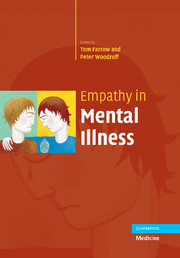Book contents
- Frontmatter
- Contents
- Foreword
- List of contributors
- Part I ‘Dysempathy’ in psychiatric samples
- Part II Empathy and related concepts in health
- Part III Empathy models, regulation and measurement of empathy
- 21 Balancing the empathy expense account: strategies for regulating empathic response
- 22 Empathic accuracy: measurement and potential clinical applications
- 23 A perception-action model for empathy
- 24 The Shared Manifold Hypothesis: embodied simulation and its role in empathy and social cognition
- 25 Using literature and the arts to develop empathy in medical students
- Index
22 - Empathic accuracy: measurement and potential clinical applications
from Part III - Empathy models, regulation and measurement of empathy
Published online by Cambridge University Press: 17 August 2009
- Frontmatter
- Contents
- Foreword
- List of contributors
- Part I ‘Dysempathy’ in psychiatric samples
- Part II Empathy and related concepts in health
- Part III Empathy models, regulation and measurement of empathy
- 21 Balancing the empathy expense account: strategies for regulating empathic response
- 22 Empathic accuracy: measurement and potential clinical applications
- 23 A perception-action model for empathy
- 24 The Shared Manifold Hypothesis: embodied simulation and its role in empathy and social cognition
- 25 Using literature and the arts to develop empathy in medical students
- Index
Summary
Introduction
Empathic inference is the ‘everyday mind reading’ that people do whenever they attempt to infer other people's thoughts and feelings. Empathic accuracy is the extent to which such everyday mind reading attempts are successful (Ickes, 1997, 2003). To put it simply, empathically accurate perceivers are those who are good at ‘reading’ other people's thoughts and feelings.
Empathic accuracy is a quintessential (indeed, perhaps the quintessential) aspect of emotional intelligence (Goleman, 1995; Ickes, 1997, 2003; Salovey & Mayer, 1989). The ability to accurately ‘read’ other people's thoughts and feelings is a fundamental skill that affects people's social adjustment in many different domains of their lives (Goleman, 1995). For example, Crosby (2002) found that mothers who were more accurate in inferring their own child's thoughts and feelings had children with more positive self-concepts as family members. And with regard to people's dating and marriage relationships, Simpson et al. (2001) found evidence that accurately ‘reading’ your partner in order to anticipate a need, avert a conflict, or keep a small problem from escalating into a large one is likely to be healthy and adaptive (Ickes et al., 2005; Simpson et al., 2001, 2003).
Empathic accuracy is a subarea of interpersonal perception research – a field of study that has a long tradition in psychology (Heider, 1944; Taft, 1955). In the early days of its study, researchers tended to focus on bias, error and inaccurate person perception rather than on accuracy.
- Type
- Chapter
- Information
- Empathy in Mental Illness , pp. 408 - 427Publisher: Cambridge University PressPrint publication year: 2007
- 14
- Cited by

